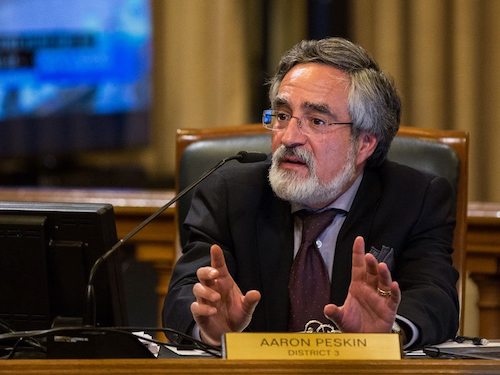Supervisor’s New Ballot Measure Misguides Voters and Actually Hurts Improvement of Retail Vacancies
Supervisor Peskin has introduced a proposed ballot measure that will be included in the November 2020 election. The new measure will penalize landlords who do not “actively promote” their properties for lease at reasonable rent rates.
His legislation would also impose an excise tax of $1,000 dollars per linear feet of street-facing frontage on property owners who keep ground floor commercial spaces in Neighborhood Commercial Districts (NCDS, also known as Neighborhood Commercial Transit Districts) beginning January 1, 2021.
In this measure, commercial spaces will not be considered “vacant” under the following conditions:
· The one-year period following the date the city issues an initial building permit for repair, rehabilitation or construction of a building or structure.
· The one-year period following the date the building or structure was severely damaged and made uninhabitable due to fire or natural disaster.
· The six-month period following the date that initial application for a conditional use permit is filed with the city.
Tax revenues generated by this measure will go to a “small business assistance” fund.
Why This Measure Won’t Work
1. The landlord has no control. The three conditions above are often out of the landlord’s control and in reality is more controlled by the city’s permit department.
Next, any natural disaster or fire triggers all kinds of code upgrades imposed by the city. Plus, you have to deal with insurance issues, financing, and construction costs. Again, this has nothing to do with a landlord’s willingness or unwillingness to rent their retail spaces.
2. Time costs money. Today, buildings are required to meet soft story renovations that have hit ground floor retail spaces in order to address seismic upgrades. This takes at least one year to complete. In addition, landlords will need extended time to complete the renovation of a retail space. This is because of financial burdens but also tenants will need to be taken into consideration when scheduling noisy construction hours. Lastly, retail tenants do not want to lease a space until they are able to start their own improvements to customize it, making it even more challenging to secure tenants.
Finally, the time it takes for landlords to obtain conditional use permits are again in the city’s control. City officials control the timeline, NOT the landlord. For example, if you were to try and secure a conditional use permit today, you are expected to wait between 6 to 12 months– and that’s without insurance that the city will even approve of the permit. This measure does not take into consideration that often times, the landlord has already agreed to rent the space to a tenant that has failed to secure their necessary permits. Again, this has nothing to do with the landlord and everything to do with the city permitting process. Landlords would be unrightfully penalized under this measure.
The REAL Issue
Supervisor Peskin’s district has one of the highest vacancy rates in the city– it keeps getting worse. The challenge with vacancies is not landlords, who are said to be greedy and unwilling to rent their spaces. They would much rather enjoy the income from having the space leased to a tenant.
In reality, the issue at hand is the restrictive city zoning requirements that ultimately prevent retailers from renting. They might be interested in renting a space, but because they do not fit the current zoning rules, they are forced to walk away and landlords are left with vacant spaces sitting. Conditional use permitting processes, formula retail restrictions, plus business taxes and wellness taxes imposed on retailers– are really what makes it difficult to make retail successful in our city.
Changes That Will Make a REAL Difference
Oakland recently imposed a similar tax and there has been no reported benefit. What Supervisor Peskin should be concentrating on is streamlining the entire permitting process. For example, when a tenant seeks a conditional use permit and within thirty days of submitting their application there are no protests, that tenant should be allowed to immediately obtain a permit. If there are protests within 90 days, then they should receive ‘yes’ or a ‘no’ on their application. Time time and money it takes to secure a conditional use permit today is seen as major risk by tenants. The city should pick up these costs to reduce risk and attract more tenants.
The city needs to revisit the formula retail laws which currently exclude retailers that have 11 stores anywhere in the world. This is outdated and ridiculous. We need all the retailers we can find in order to truly address our vacancy problems.
We also need to give businesses a chance to lease space and not impose a neighborhood vote onto every single retailer. If a retailer goes in and the neighborhood does not want the retailer, they don’t have to shop there and the retailer will fail naturally fail on its own. It would be better to let a retailer test their product or service rather than have a vacant storefront sitting for months. For instance, Geary boulevard is lined with vacancies, yet formula retail restrictions are enforced heavily in this district. Instead of helping local retailers, we are killing them.
In 2015, the overall retail vacancy in San Francisco was 6.2 percent. Today, it’s 19.7 percent and it is projected to be 23.5 percent by 2021.
We have a real emergency here and we need first to truly understand the complex process facing retailers. This means speaking with retailers and retail brokers to learn their perspective. We also need to include landlords in the discussion, instead of viewing them negatively in measures like this. Let’s find out what their motivations and desires are for space. From there, we need to create a plan to take effect immediately, change the way our city doesbusiness, and fix this troubling trend.
